Xing Zhou
Open-Sora Plan: Open-Source Large Video Generation Model
Nov 28, 2024


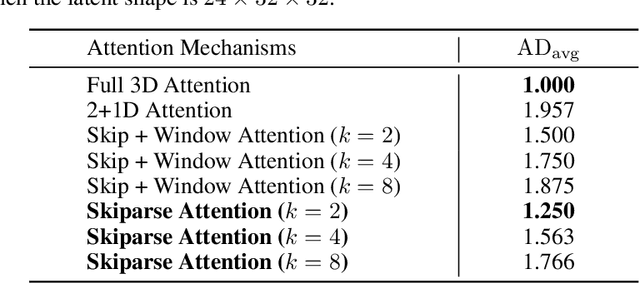
Abstract:We introduce Open-Sora Plan, an open-source project that aims to contribute a large generation model for generating desired high-resolution videos with long durations based on various user inputs. Our project comprises multiple components for the entire video generation process, including a Wavelet-Flow Variational Autoencoder, a Joint Image-Video Skiparse Denoiser, and various condition controllers. Moreover, many assistant strategies for efficient training and inference are designed, and a multi-dimensional data curation pipeline is proposed for obtaining desired high-quality data. Benefiting from efficient thoughts, our Open-Sora Plan achieves impressive video generation results in both qualitative and quantitative evaluations. We hope our careful design and practical experience can inspire the video generation research community. All our codes and model weights are publicly available at \url{https://github.com/PKU-YuanGroup/Open-Sora-Plan}.
OD-VAE: An Omni-dimensional Video Compressor for Improving Latent Video Diffusion Model
Sep 02, 2024Abstract:Variational Autoencoder (VAE), compressing videos into latent representations, is a crucial preceding component of Latent Video Diffusion Models (LVDMs). With the same reconstruction quality, the more sufficient the VAE's compression for videos is, the more efficient the LVDMs are. However, most LVDMs utilize 2D image VAE, whose compression for videos is only in the spatial dimension and often ignored in the temporal dimension. How to conduct temporal compression for videos in a VAE to obtain more concise latent representations while promising accurate reconstruction is seldom explored. To fill this gap, we propose an omni-dimension compression VAE, named OD-VAE, which can temporally and spatially compress videos. Although OD-VAE's more sufficient compression brings a great challenge to video reconstruction, it can still achieve high reconstructed accuracy by our fine design. To obtain a better trade-off between video reconstruction quality and compression speed, four variants of OD-VAE are introduced and analyzed. In addition, a novel tail initialization is designed to train OD-VAE more efficiently, and a novel inference strategy is proposed to enable OD-VAE to handle videos of arbitrary length with limited GPU memory. Comprehensive experiments on video reconstruction and LVDM-based video generation demonstrate the effectiveness and efficiency of our proposed methods.
ADSNet: Cross-Domain LTV Prediction with an Adaptive Siamese Network in Advertising
Jun 15, 2024Abstract:Advertising platforms have evolved in estimating Lifetime Value (LTV) to better align with advertisers' true performance metric. However, the sparsity of real-world LTV data presents a significant challenge to LTV predictive model(i.e., pLTV), severely limiting the their capabilities. Therefore, we propose to utilize external data, in addition to the internal data of advertising platform, to expand the size of purchase samples and enhance the LTV prediction model of the advertising platform. To tackle the issue of data distribution shift between internal and external platforms, we introduce an Adaptive Difference Siamese Network (ADSNet), which employs cross-domain transfer learning to prevent negative transfer. Specifically, ADSNet is designed to learn information that is beneficial to the target domain. We introduce a gain evaluation strategy to calculate information gain, aiding the model in learning helpful information for the target domain and providing the ability to reject noisy samples, thus avoiding negative transfer. Additionally, we also design a Domain Adaptation Module as a bridge to connect different domains, reduce the distribution distance between them, and enhance the consistency of representation space distribution. We conduct extensive offline experiments and online A/B tests on a real advertising platform. Our proposed ADSNet method outperforms other methods, improving GINI by 2$\%$. The ablation study highlights the importance of the gain evaluation strategy in negative gain sample rejection and improving model performance. Additionally, ADSNet significantly improves long-tail prediction. The online A/B tests confirm ADSNet's efficacy, increasing online LTV by 3.47$\%$ and GMV by 3.89$\%$.
VISION2UI: A Real-World Dataset with Layout for Code Generation from UI Designs
Apr 09, 2024Abstract:Automatically generating UI code from webpage design visions can significantly alleviate the burden of developers, enabling beginner developers or designers to directly generate Web pages from design diagrams. Currently, prior research has accomplished the objective of generating UI code from rudimentary design visions or sketches through designing deep neural networks. Inspired by the groundbreaking advancements achieved by Multimodal Large Language Models (MLLMs), the automatic generation of UI code from high-fidelity design images is now emerging as a viable possibility. Nevertheless, our investigation reveals that existing MLLMs are hampered by the scarcity of authentic, high-quality, and large-scale datasets, leading to unsatisfactory performance in automated UI code generation. To mitigate this gap, we present a novel dataset, termed VISION2UI, extracted from real-world scenarios, augmented with comprehensive layout information, tailored specifically for finetuning MLLMs in UI code generation. Specifically, this dataset is derived through a series of operations, encompassing collecting, cleaning, and filtering of the open-source Common Crawl dataset. In order to uphold its quality, a neural scorer trained on labeled samples is utilized to refine the data, retaining higher-quality instances. Ultimately, this process yields a dataset comprising 2,000 (Much more is coming soon) parallel samples encompassing design visions and UI code. The dataset is available at https://huggingface.co/datasets/xcodemind/vision2ui.
Envision3D: One Image to 3D with Anchor Views Interpolation
Mar 13, 2024



Abstract:We present Envision3D, a novel method for efficiently generating high-quality 3D content from a single image. Recent methods that extract 3D content from multi-view images generated by diffusion models show great potential. However, it is still challenging for diffusion models to generate dense multi-view consistent images, which is crucial for the quality of 3D content extraction. To address this issue, we propose a novel cascade diffusion framework, which decomposes the challenging dense views generation task into two tractable stages, namely anchor views generation and anchor views interpolation. In the first stage, we train the image diffusion model to generate global consistent anchor views conditioning on image-normal pairs. Subsequently, leveraging our video diffusion model fine-tuned on consecutive multi-view images, we conduct interpolation on the previous anchor views to generate extra dense views. This framework yields dense, multi-view consistent images, providing comprehensive 3D information. To further enhance the overall generation quality, we introduce a coarse-to-fine sampling strategy for the reconstruction algorithm to robustly extract textured meshes from the generated dense images. Extensive experiments demonstrate that our method is capable of generating high-quality 3D content in terms of texture and geometry, surpassing previous image-to-3D baseline methods.
LLMBind: A Unified Modality-Task Integration Framework
Mar 08, 2024Abstract:While recent progress in multimodal large language models tackles various modality tasks, they posses limited integration capabilities for complex multi-modality tasks, consequently constraining the development of the field. In this work, we take the initiative to explore and propose the LLMBind, a unified framework for modality task integration, which binds Large Language Models and corresponding pre-trained task models with task-specific tokens. Consequently, LLMBind can interpret inputs and produce outputs in versatile combinations of image, text, video, and audio. Specifically, we introduce a Mixture-of-Experts technique to enable effective learning for different multimodal tasks through collaboration among diverse experts. Furthermore, we create a multi-task dataset comprising 400k instruction data, which unlocks the ability for interactive visual generation and editing tasks. Extensive experiments show the effectiveness of our framework across various tasks, including image, video, audio generation, image segmentation, and image editing. More encouragingly, our framework can be easily extended to other modality tasks, showcasing the promising potential of creating a unified AI agent for modeling universal modalities.
Efficient Large Scale Language Modeling with Mixtures of Experts
Dec 20, 2021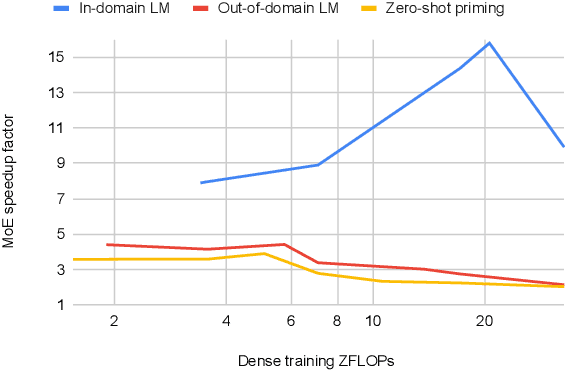

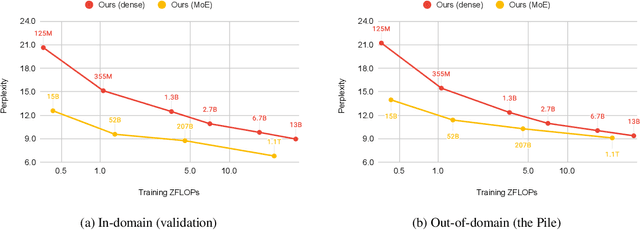
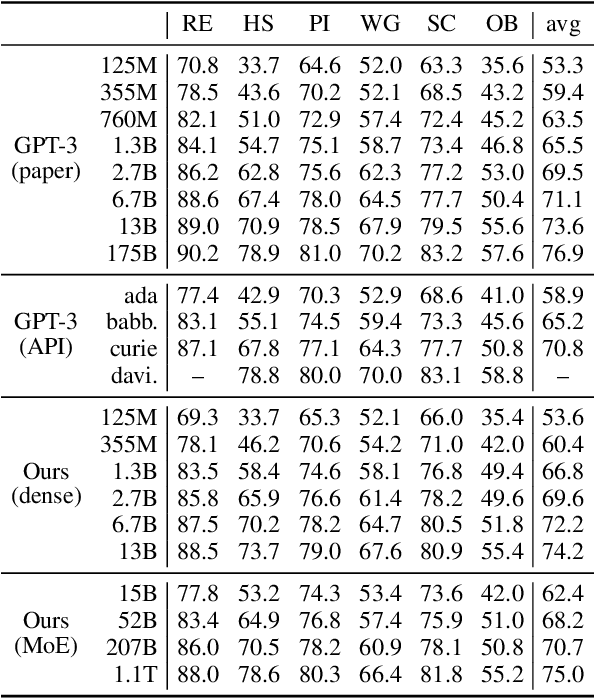
Abstract:Mixture of Experts layers (MoEs) enable efficient scaling of language models through conditional computation. This paper presents a detailed empirical study of how autoregressive MoE language models scale in comparison with dense models in a wide range of settings: in- and out-of-domain language modeling, zero- and few-shot priming, and full fine-tuning. With the exception of fine-tuning, we find MoEs to be substantially more compute efficient. At more modest training budgets, MoEs can match the performance of dense models using $\sim$4 times less compute. This gap narrows at scale, but our largest MoE model (1.1T parameters) consistently outperforms a compute-equivalent dense model (6.7B parameters). Overall, this performance gap varies greatly across tasks and domains, suggesting that MoE and dense models generalize differently in ways that are worthy of future study. We make our code and models publicly available for research use.
General Purpose Text Embeddings from Pre-trained Language Models for Scalable Inference
Apr 29, 2020
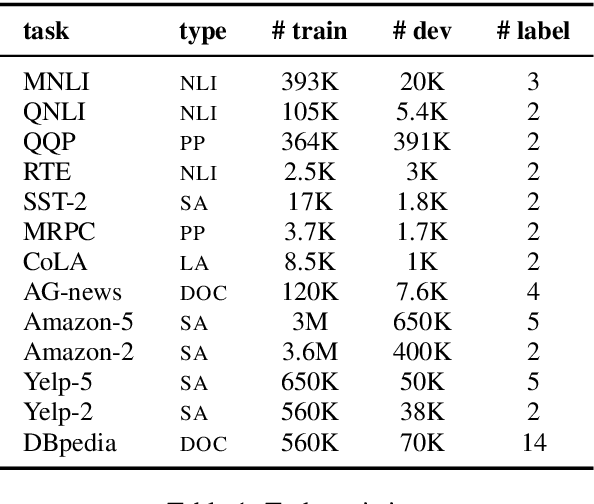
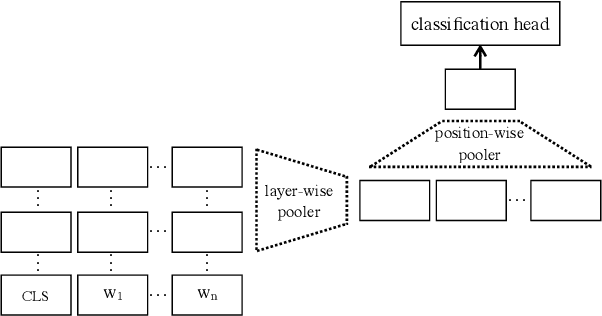
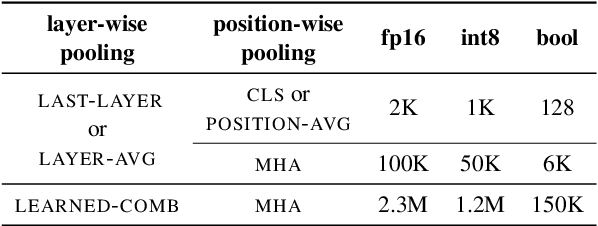
Abstract:The state of the art on many NLP tasks is currently achieved by large pre-trained language models, which require a considerable amount of computation. We explore a setting where many different predictions are made on a single piece of text. In that case, some of the computational cost during inference can be amortized over the different tasks using a shared text encoder. We compare approaches for training such an encoder and show that encoders pre-trained over multiple tasks generalize well to unseen tasks. We also compare ways of extracting fixed- and limited-size representations from this encoder, including different ways of pooling features extracted from multiple layers or positions. Our best approach compares favorably to knowledge distillation, achieving higher accuracy and lower computational cost once the system is handling around 7 tasks. Further, we show that through binary quantization, we can reduce the size of the extracted representations by a factor of 16 making it feasible to store them for later use. The resulting method offers a compelling solution for using large-scale pre-trained models at a fraction of the computational cost when multiple tasks are performed on the same text.
Keyphrase Extraction with Span-based Feature Representations
Feb 13, 2020



Abstract:Keyphrases are capable of providing semantic metadata characterizing documents and producing an overview of the content of a document. Since keyphrase extraction is able to facilitate the management, categorization, and retrieval of information, it has received much attention in recent years. There are three approaches to address keyphrase extraction: (i) traditional two-step ranking method, (ii) sequence labeling and (iii) generation using neural networks. Two-step ranking approach is based on feature engineering, which is labor intensive and domain dependent. Sequence labeling is not able to tackle overlapping phrases. Generation methods (i.e., Sequence-to-sequence neural network models) overcome those shortcomings, so they have been widely studied and gain state-of-the-art performance. However, generation methods can not utilize context information effectively. In this paper, we propose a novelty Span Keyphrase Extraction model that extracts span-based feature representation of keyphrase directly from all the content tokens. In this way, our model obtains representation for each keyphrase and further learns to capture the interaction between keyphrases in one document to get better ranking results. In addition, with the help of tokens, our model is able to extract overlapped keyphrases. Experimental results on the benchmark datasets show that our proposed model outperforms the existing methods by a large margin.
 Add to Chrome
Add to Chrome Add to Firefox
Add to Firefox Add to Edge
Add to Edge